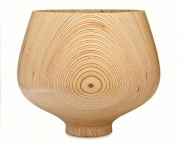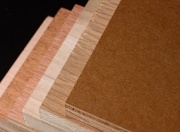Difference between revisions of "Plywood"
(username removed) |
(username removed) |
||
| Line 2: | Line 2: | ||
== Description == | == Description == | ||
| − | A layered assembly of hardwood or softwood veneers bonded together at right angles with an adhesive. Plywood was originally called scale boards in a 1865 patent. In the nineteenth century, plywood was manufactured from hardwoods ([http://cameo.mfa.org/materials/fullrecord.asp?name=maple maple], [http://cameo.mfa.org/materials/fullrecord.asp?name=birch birch], etc.) and used by furniture makers for concealed parts such as drawer bottoms. By the beginning of the 20th century, plywood was used for doors, seats, and desk tops. Douglas fir softwood plywood was first made in 1905; southern pine became extensively used in 1964 for softwood plywood. Plywood has been used in airplanes, automobiles, and house construction. Early panels were adhered with [http://cameo.mfa.org/materials/fullrecord.asp?name=hide | + | A layered assembly of hardwood or softwood veneers bonded together at right angles with an adhesive. Plywood was originally called scale boards in a 1865 patent. In the nineteenth century, plywood was manufactured from hardwoods ([http://cameo.mfa.org/materials/fullrecord.asp?name=maple maple], [http://cameo.mfa.org/materials/fullrecord.asp?name=birch birch], etc.) and used by furniture makers for concealed parts such as drawer bottoms. By the beginning of the 20th century, plywood was used for doors, seats, and desk tops. Douglas fir softwood plywood was first made in 1905; southern pine became extensively used in 1964 for softwood plywood. Plywood has been used in airplanes, automobiles, and house construction. Early panels were adhered with [http://cameo.mfa.org/materials/fullrecord.asp?name=hide%20glue hide glue], [http://cameo.mfa.org/materials/fullrecord.asp?name=blood%20glue blood glue], [http://cameo.mfa.org/materials/fullrecord.asp?name=cassava%20starch cassava flour], [http://cameo.mfa.org/materials/fullrecord.asp?name=casein%20adhesive casein glue], and [http://cameo.mfa.org/materials/fullrecord.asp?name=soybean%20glue soybean glue]. In 1935, plywood was made with synthetic thermosetting formaldehyde adhesives ([http://cameo.mfa.org/materials/fullrecord.asp?name=phenol%20formaldehyde%20resin phenol formaldehyde], and [http://cameo.mfa.org/materials/fullrecord.asp?name=urea%20formaldehyde%20resin urea formaldehyde]). By 1939 [http://cameo.mfa.org/materials/fullrecord.asp?name=melamine%20formaldehyde%20resin melamine formaldehyde] resins were used and a few years later [http://cameo.mfa.org/materials/fullrecord.asp?name=resorcinol%20formaldehyde%20resin resorcinol] adhesives were also in use. Currently, water-resistant phenol formaldehyde adhesives are used for exterior-use plywood and urea formaldehyde resins are used in interior-use plywood. Plywood has a high strength-to weight ratio, is resistant to splitting, can be molded into compound curves, and is more dimensionally stable than solid wood. |
[[File:plywood.jpg|thumb|Plywoods]] | [[File:plywood.jpg|thumb|Plywoods]] | ||
== Synonyms and Related Terms == | == Synonyms and Related Terms == | ||
| − | laminated wood; Holzwerkstoff (Deut.); contrachapado (Esp.); tripley (Esp.); | + | laminated wood; Holzwerkstoff (Deut.); contrachapado (Esp.); tripley (Esp.); contreplaqué (Fr.); compensato (It.); triplex (Ned.); multiplex (Ned.); sklejka (Pol.); contraplacado (Port.); veneered construction; Plyshield; Haskelite; Harbord; Plankweld; Plycrete; Plymetal; Weldtex; Weldwood; scale board |
== Hazards and Safety == | == Hazards and Safety == | ||
| Line 21: | Line 21: | ||
* ''Dictionary of Building Preservation'', Ward Bucher, ed., John Wiley & Sons, Inc., New York City, 1996 | * ''Dictionary of Building Preservation'', Ward Bucher, ed., John Wiley & Sons, Inc., New York City, 1996 | ||
| − | * | + | * Thomas C. Jester (ed.), ''Twentieth-Century Building Materials'', McGraw-Hill Companies, Washington DC, 1995 |
| − | * ''Encyclopedia Britannica'', http://www.britannica.com Comment: wood" | + | * ''Encyclopedia Britannica'', http://www.britannica.com Comment: wood" Encyclopædia Britannica [Accessed October 31, 2001]. |
| − | * | + | * R. J. Gettens, G.L. Stout, ''Painting Materials, A Short Encyclopaedia'', Dover Publications, New York, 1966 |
| − | * | + | * G.S.Brady, ''Materials Handbook'', McGraw-Hill Book Co., New York, 1971 Comment: p. 618 |
| − | * | + | * Ralph Mayer, ''A Dictionary of Art Terms and Techniques'', Harper and Row Publishers, New York, 1969 (also 1945 printing) |
* ''Caring for your Collections'', Arthur W Schulz (ed.), Harry N. Abrams, Inc. , New York, 1992 | * ''Caring for your Collections'', Arthur W Schulz (ed.), Harry N. Abrams, Inc. , New York, 1992 | ||
| − | * | + | * Pam Hatchfield, ''Pollutants in the Museum Environment'', Archetype Press, London, 2002 |
| − | * | + | * Richard S. Lewis, ''Hawley's Condensed Chemical Dictionary'', Van Nostrand Reinhold, New York, 10th ed., 1993 |
| − | * | + | * Theodore J. Reinhart, 'Glossary of Terms', ''Engineered Plastics'', ASM International, 1988 |
| − | * | + | * Random House, ''Webster's Encyclopedic Unabridged Dictionary of the English Language'', Grammercy Book, New York, 1997 |
* ''The American Heritage Dictionary'' or ''Encarta'', via Microsoft Bookshelf 98, Microsoft Corp., 1998 | * ''The American Heritage Dictionary'' or ''Encarta'', via Microsoft Bookshelf 98, Microsoft Corp., 1998 | ||
Revision as of 06:45, 24 July 2013
Description
A layered assembly of hardwood or softwood veneers bonded together at right angles with an adhesive. Plywood was originally called scale boards in a 1865 patent. In the nineteenth century, plywood was manufactured from hardwoods (maple, birch, etc.) and used by furniture makers for concealed parts such as drawer bottoms. By the beginning of the 20th century, plywood was used for doors, seats, and desk tops. Douglas fir softwood plywood was first made in 1905; southern pine became extensively used in 1964 for softwood plywood. Plywood has been used in airplanes, automobiles, and house construction. Early panels were adhered with hide glue, blood glue, cassava flour, casein glue, and soybean glue. In 1935, plywood was made with synthetic thermosetting formaldehyde adhesives (phenol formaldehyde, and urea formaldehyde). By 1939 melamine formaldehyde resins were used and a few years later resorcinol adhesives were also in use. Currently, water-resistant phenol formaldehyde adhesives are used for exterior-use plywood and urea formaldehyde resins are used in interior-use plywood. Plywood has a high strength-to weight ratio, is resistant to splitting, can be molded into compound curves, and is more dimensionally stable than solid wood.
Synonyms and Related Terms
laminated wood; Holzwerkstoff (Deut.); contrachapado (Esp.); tripley (Esp.); contreplaqué (Fr.); compensato (It.); triplex (Ned.); multiplex (Ned.); sklejka (Pol.); contraplacado (Port.); veneered construction; Plyshield; Haskelite; Harbord; Plankweld; Plycrete; Plymetal; Weldtex; Weldwood; scale board
Hazards and Safety
Some plywoods contain urea-formaldehyde adhesives which emit formaldehyde.
Additional Information
Thomas Jester, "Plywood", in Twentieth-Century Building Materials, T. Jester (ed.), McGraw-Hill: New York, 1995.
Authority
- Dictionary of Building Preservation, Ward Bucher, ed., John Wiley & Sons, Inc., New York City, 1996
- Thomas C. Jester (ed.), Twentieth-Century Building Materials, McGraw-Hill Companies, Washington DC, 1995
- Encyclopedia Britannica, http://www.britannica.com Comment: wood" Encyclopædia Britannica [Accessed October 31, 2001].
- R. J. Gettens, G.L. Stout, Painting Materials, A Short Encyclopaedia, Dover Publications, New York, 1966
- G.S.Brady, Materials Handbook, McGraw-Hill Book Co., New York, 1971 Comment: p. 618
- Ralph Mayer, A Dictionary of Art Terms and Techniques, Harper and Row Publishers, New York, 1969 (also 1945 printing)
- Caring for your Collections, Arthur W Schulz (ed.), Harry N. Abrams, Inc. , New York, 1992
- Pam Hatchfield, Pollutants in the Museum Environment, Archetype Press, London, 2002
- Richard S. Lewis, Hawley's Condensed Chemical Dictionary, Van Nostrand Reinhold, New York, 10th ed., 1993
- Theodore J. Reinhart, 'Glossary of Terms', Engineered Plastics, ASM International, 1988
- Random House, Webster's Encyclopedic Unabridged Dictionary of the English Language, Grammercy Book, New York, 1997
- The American Heritage Dictionary or Encarta, via Microsoft Bookshelf 98, Microsoft Corp., 1998

